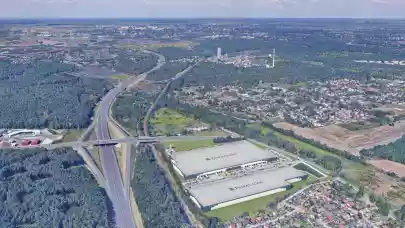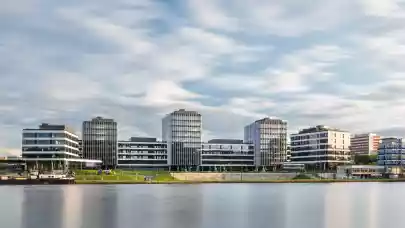
New multinational companies are leasing warehouses in Upper Silesia while taking advantage of comprehensive logistics services. Developers have secured plots of land in the region and will launch new projects once they pre-let 30-50% of the floorspace of a building as part of meeting banks’ lending requirements. According to the latest market data, Upper Silesia is the fastest-growing region, say Michał Kozar, Senior Associate, and Janusz Dudek, Senior Advisor, Industrial and Warehouse Department, Newmark Polska.
Upper Silesia is the second-largest industrial market in Poland after Warsaw. In 2022, more than 539,000 sqm came on stream, bringing the region’s total stock up to 4.77 million sqm. New completions for the first quarter of this year totalled 256,000 sqm. The key competitive advantage of Upper Silesia lies in its location and first-rate east-west and north-south roads. In addition, the last section of the A1 motorway, which further improved connectivity between the Baltic Sea and Czechia, was completed at the end of April this year.
Employment in manufacturing and warehousing is rising
Upper Silesia beckons companies with a large pool of workers with technical skills who are crucial to the success of any industrial and warehouse project. “Demand for employees in manufacturing and warehousing has increased significantly since the beginning of the year. Having navigated through the epidemic-induced crisis and the economic turmoil caused by the war in Ukraine, most companies are doing their best to resume normal operations and to fill up order books – this will mean more production and a greater workload for logistics centres. Demand for people to work in manufacturing and warehousing is actually growing by the month”, says Małgorzata Mudyna, Regional Manager, Randstad Polska.
Katarzyna Fojcik, Regional Manager, Randstad Polska, notes that the region is well-serviced by public transport, which makes it easier for employers to reach out to the right job candidates. “Upper Silesia is still a magnet for people from across the country – both skilled and unskilled labour. Graduates and technical workers are attracted to this region by the rapid growth in new investment. They increasingly favour a clean, light manufacturing setting in modern industrial parks over heavy manufacturing jobs in traditional plants such as stamping plants or steelworks, so a modern working environment is an important incentive for candidates”, explains the expert.
Poor employee retention in the region, particularly in the largest urban areas, caused by intense competition for candidates is likely to be a challenge for companies, reveals Randstad. The greatest labour shortages include technical workers: CNC operators, milling machine operators, toolmakers and welders. Katarzyna Fojcik adds that candidate availability varies across the region. The more distant a location is from cities such as Gliwice or Katowice, the more difficult it is to recruit suitably skilled staff. Difficulties with sourcing employees are likely in smaller towns such as Lubliniec and Imielin.
Plenty of completions, few new starts
Analyses of the first quarter of this year by Newmark Polska show that although industrial development activity slowed, Upper Silesia continues to stand out on the warehouse map of Poland with the highest level of new completions in the first three months (256,100 sqm - the second best result nationwide) and the third highest result for both take-up and development pipeline, with 191,200 sqm transacted and 267,060 sqm of stock under construction, respectively.
New deliveries in the period January-March 2023 comprised three BTS (build to suit) schemes, including one extension, and eight buildings within existing industrial parks: CTPark Katowice, CTPark Zabrze, MLP Czeladź, GLP Lędziny Logistics Center and Panattoni Park Zabrze II. Vacant stock in Upper Silesia amounts to more than 333,000 sqm in existing parks and close to 120,000 sqm in facilities under construction.
“The large volume of new completions last year improved warehouse availability in Upper Silesia and pushed the region’s vacancy rate up to 6.6% in the first quarter of this year. In addition, buildings whose construction was planned prior to the war in Ukraine are expected to be delivered to the market in the near future. Project preparations and financing that commenced before February last year were not put on hold”, says Michał Kozar, Newmark Polska. “Due to high finance costs, stubbornly high inflation and banks’ tighter lending criteria, there are fewer new starts, which will soon cause the market to absorb the surplus warehouse space from existing stock, subsequently leading to shortages in the years ahead. Speculative developments are rare. The current market standard is to wait for a large tenant who will sign a contract for about half of a warehouse building and enable the developer to secure financing and begin construction.”
Advisors from Newmark Polska also note that the warehouse take-up structure has changed – it remains dominated by large deals, but there are significantly fewer such leases than one or two years ago. “We mostly advise on leases for 20,000-30,000 sqm and more. The number of enquiries about smaller units sized between 5,000-6,000 sqm has fallen due to the serious concerns of small and medium-sized companies about the impact of economic slowdown on their business. Large enterprises are in a much better position thanks to the resources and credit ratings they have. Many are growing to expand their market share. Due to the shift towards large leases, the processes taking place on the industrial market are a lot slower. Large deals are more complicated, take longer to negotiate and agree on technical adaptations of a building, and decision-making processes in large companies are significantly longer than in small firms”, says Janusz Dudek, Newmark Polska.
Demand comes from e-commerce, manufacturing and logistics
Leasing volumes are expected to decline in the coming months. Activity in Upper Silesia, which is a large and stable market, remains strong but is visibly weaker. Michał Kozar, Newmark Polska: “Despite tight market conditions, we finalized one of this year’s larger transactions with our client in recent months. Regesta leased 33,000 sqm in Panattoni Park Ruda Śląska V to open the largest logistics centre in this region – a customized warehouse that our client will move into in the first quarter of next year.”
Janusz Dudek of Newmark Polska notes a few other large projects underway in Upper Silesia: “Last year, Lidl signed a contract for the construction of a 60,000 sqm warehouse in Panattoni Park Sosnowiec III, in Lenartowicza Street, which will be operated by logistics company Rhenus. An interesting example of a project for a manufacturing tenant will be the adaptation of a building within the industrial park Hillwood Piekary Śląskie for Footprint’s paper packaging factory. Its 40,200 sqm of manufacturing space is scheduled for completion this year.”
Everyone wants to invest in Upper Silesia. Waiting for banks
Rents in Upper Silesia, as in the whole country, continued to trend upwards but have now stabilized at €3.80–5.25 per square metre per month. “Upper Silesia is an important warehouse market where developers, funds and tenant companies alike want to invest. All of them are waiting for lending criteria to be eased and a cut in interest rates. Once developers are able to fund projects faster and more cheaply, the market should bounce back quite quickly”, says Michał Kozar.
Janusz Dudek says that Upper Silesia still has a huge potential and it has seen many newcomers enter its market, with other international companies ready to follow suit. “Most sign full service contracts with logistics operators. Upper Silesia is the key growth market for the largest developers in Poland who have secured plots for more warehouse projects in the region. With the market being calmer and more subdued, they also have more time to prepare plots of land that will be ready for the first shovel to hit the ground once a large tenant comes along and financing is secured.”



